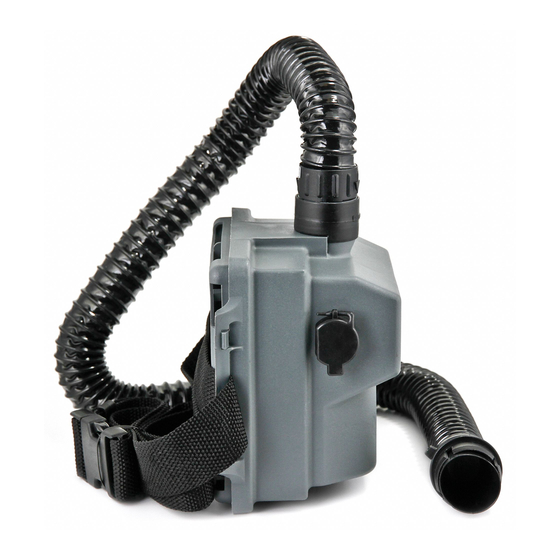3M Air-Mate PAPR 520-03-63R01 User Instructions - Page 11
Browse online or download pdf User Instructions for Respiratory Product 3M Air-Mate PAPR 520-03-63R01. 3M Air-Mate PAPR 520-03-63R01 17 pages. Belt-mounted high efficiency powered air purifying respirator
Also for 3M Air-Mate PAPR 520-03-63R01: Manual (2 pages)

battery from overcharge. For Canada chargers, when in trickle mode, the LED light will cycle on and off
every 3 – 5 seconds. 3M batteries provide up to 500 charge/discharge cycles. However, the life of 3M
batteries will be significantly reduced when they are exposed to high heat over an extended period of time.
To maximize battery life, these guidelines should be followed:
–
Charge 3M battery packs before they are completely discharged. Damage may occur if the battery pack
is completely discharged ("deep discharged") frequently.
–
3M battery packs may be charged any time during the discharge cycle. Unlike some NiCd batteries, 3M
battery packs do not develop a "memory". Whether it has been used 30 minutes or 8 hours, the battery
pack may be charged.
–
Always charge batteries at a temperature of 77° F (25º C) or less. At higher temperatures, the battery
pack may not accept a full charge. If a battery pack feels hot, let it cool for 1/2-hour before charging.
–
Batteries may be left on trickle rate mode to maintain optimum capacity for up to 30 days. Without
periodic charging, a NiCd battery in storage loses approximately 1% of its charge each day. Infrequently
used battery packs should be fully charged, initially, then charged overnight once per week or one hour
each day to maintain a full charge. Allowing a battery to self-discharge during extended storage will not
harm the battery pack. Batteries subjected to prolonged storage (longer than 6 months) may loose their
capacity to hold a full charge. Battery capacity can be checked by running the PAPR motor/blower unit
for eight hours and checking that airflow is maintained at six CFM or greater. Several charge/run-down
cycles may restore battery capacity.
Do not charge multiple battery packs in an enclosed cabinet without ventilation.
–
–
To properly dispose of the battery pack, follow local solid waste disposal regulations or call the RBRC
Battery Recycling Information Helpline at 1-800--8-BATTERY (1-800-822-8837).
Filter and Filter Gasket
The high efficiency filter must be changed:
–
When an airflow check of the PAPR unit reveals that the airflow indicator does not rise to the specified
level (with a properly charged battery pack powering the PAPR unit);
–
When the filter has been physically damaged;
-
When water has entered the high efficiency filter; or
-
In order to comply with local administrative procedures. Examine the new high efficiency filter, and if
no damage is evident, change the filter as follows.
Removal
Pull the belt through the belt retainers to form a loop, which is clear of the PAPR unit. Release the back
cover's locking tabs and remove the back cover.
Remove and discard the high efficiency filter and filter gasket in accordance with local, state, and federal
guidelines.
Replacement
Inspect the new filter gasket and ensure that it is not torn or damaged before proceeding. Fit the new filter
gasket into the filter support ridge ensuring that the gasket is flush against the sides of the PAPR unit, leaving
no gaps.
Fit the replacement filter into the PAPR unit with the arrows pointing into the PAPR unit.
Snap the back cover's locking tabs into the rear of the PAPR unit. Pull the belt through the belt retainers.
11
